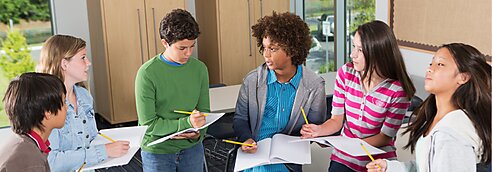This lesson plan is intended to fit within any middle school learning unit in a variety of classes. This lesson should be included as a routine or method to be used repeatedly throughout the year, rather than as a stand‐alone lesson to be taught once and forgotten. To help students improve their oracy skills they need frequent practice and scaffolding to be able to state their ideas with strong reasoning while respecting others’ viewpoints, self‐regulate their own behavior, and develop metacognition of their own thought process.


Prior to this lesson, the teacher will have dedicated the previous class period to a class discussion on what group talk norms should be. The class will have created their own poster on talk norms, and it should have been posted on the walls. The norms poster can also be used to offer suggestions for group discussion behavior, and it can be posted in the classroom for students to refer to during group discussions as well. In addition, each student should have been provided with a copy of the sentence stems to scaffold their speaking interactions during today’s discussion, and these sentence stems should also have been posted in the classroom for student reference. Previous discussion of healthy discourse norms and sentence stems will help the lesson to go smoothly.
Topic and Context
This lesson can be taught in many middle grade classes, including social studies, language arts, science, STEM, etc. The lesson will be included multiple times throughout the year to help students practice healthy discourse skills. Although the topic will change each time, the routines, class norms, talk stems, and Big Idea of the lesson will remain the same each time the lesson is repeated. As a topic for discussion, the teacher will preselect appropriate content from the resource Both Sides. Teachers should choose topics that are appropriate for their students and the content they are teaching.
Objective
Students will learn how to productively consider and discuss different sides of a topic with support using class norms, talk stems, and information from the website Both Sides. The class will practice active listening and healthy discourse skills to connect, challenge, support, and encourage their peers during productive group discussions.
Accessibility
Closed captions are available on the Both Sides videos to help students understand the video content. Multilingual learners can be paired with students of higher English proficiency to model and encourage them to participate in discussion. Talk stems and posters will be visible to students throughout the discussion to remind them of group norms and discussion starters.